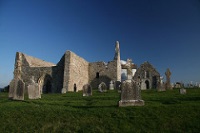
Clonmacnoise is Ireland's most important monastic site, and it's situated in Shannonbridge, west of Dublin in County Offaly. It was founded by Saint Ciaran in the 6th-century, on the banks of the River Shannon. It includes the ruins of a cathedral, eight churches (10th to 13th-century), two round towers, and three high crosses.The site is extremely atmospheric, with some beautiful ancient stonework, and it provides the visitor with a real sense of what monasteries must have been like in their day. Everything still feels authentic and the spirit of the place has been preserved. The Visitor Centre displays a large collection of grave slabs, hosts numerous exhibitions and provides further interest with an audio-visual show. It is a good idea to start with a browse around the museum to get some historical context before exploring the ruins, many of which are remarkably intact. There is lots to see and explore and Clonmacnoise offers some really glorious photographic opportunities. Although it is ideal to visit in good weather, as the whole site is worth exploring, the ancient monastery can ignite the imagination despite mist and drizzle. As this is a very popular attraction, visitors may experience queues during the summer months.
Address : Clonmacnoise, Shannonbridge, Athlone, County Offaly.
Telephone : +353 90 9674195
Opening times : November to mid-March: 10am-5.30pm Mid-March to mid-May: 10am-6pm June to August: 9am-6.30pm September to October: 10am-6p
Admission : Adults €8, Children and Students €4. Concessions available.
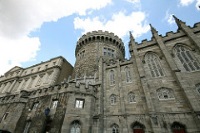
Dublin Castle is at the very heart of the historic city. It was founded in 1204 by order of King John, who wanted a fortress constructed for the administration of the city. It has been added to and rebuilt many times so that all that remains of the original structure is the Norman Tower. By the early 17th century, the castle was fully developed with Law Courts, meetings of Parliament, the residence of the viceroy and a council chamber. The magnificent, gilded State Apartments were added in the 18th century and are still used for state occasions today.Highlights of the castle include the Throne Room, St Patrick's Hall and the Ladies Drawing Room. The gardens are also great for a stroll or relaxing, and there are some interesting sculptures to investigate. The gardens can be accessed by the public for free. There is a restaurant and a Heritage Centre, as well as a gift shop. You can only explore the castle on official guided tours which start every 20 minutes and take about an hour. Groups are required to book in advance. There are plenty of attractions at the castle to explore in your own time though, like the Chester Beatty Library. Note that the castle is used for state functions and is sometimes closed on short notice. Check the website to ensure it is open for your visit.
Address : Dame Street
Telephone : +353 1 645 8813
Opening times : Monday to Sunday and Public holidays 9.45am-5.15pm. Admission is by guided tour, with a self-guiding option available.
Admission : One hour guided tour: Adults €12, Children under 17 €6. 30 minute self-guided tour: Adults €8, Children €4. Concessions available.
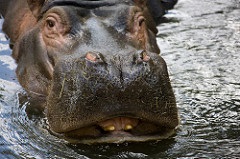
The Dublin Zoo is one of Ireland's most popular attractions for children. It takes visitors on a voyage of discovery from the Arctic to the Plains of Africa via an Indian Rainforest. The zoo houses more than 600 animals and the habitats are impressive, with lots of information provided on each species.The zoo provides plenty of entertainment for kids, with free arts and crafts activities like face painting, and a number of little playgrounds dotted around the park. Visitors can see lions and tigers, Asian elephants, gorillas, chimpanzees and orangutans, rare monkeys, rhinos, hippos, giraffes and many more exotic and endangered species, including extremely rare species like the snow leopard. There is also a pet's corner for children, a city farm and a safari train ride around the African Plains.Although it is an old zoo, it is recognised as one of the most modern in Europe, and it places emphasis on learning about wildlife and conservation. The Dublin Zoo is a registered charity and all profits will go towards maintenance and improvement. There are a number of snack stalls and a restaurant on the premises, but visitors can also bring their own picnics.
Address : Phoenix Park
Website : www.dublinzoo.ie
Telephone : +353 1 4748900
Transport : Buses: Nos. 25, 26, 46A, 66 / 66A / 66B, 67, 69 LUAS Red Line: Dublin Zoo is a 15 minute walk from the Heuston Station stop.
Opening times : Open from 9.30am Monday to Sunday. Closing times vary between 4pm and 6pm, depending on the season.
Admission : Adults €18, Children (3-16) €13.50. Concessions available.
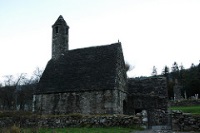
Located just south of Dublin, Glendalough is a very popular destination for day-trippers. Although it gets busy, the site has a very tangible spirituality that can be experienced whilst standing amidst the remains of the monastic settlement. The Gaelic name translates to 'valley of the two lakes' and there are beautiful walks around the ruined monastery and along the clear-as-glass lakes.St Kevin founded the monastery in the 6th century and it became a great European centre for learning. His body lies in the 9th century cathedral. The site is adorned with St Kevin's Cross, carved in about 1150. Other buildings here have survived from the 8th and 12th centuries, the most famous of which is the round tower, standing 112ft (34m) high with a base measuring 52ft (16m) in circumference.Glendalough is a remarkable place both in its profound history and its natural splendour. Photographers will be in heaven with the scenery and the romantic ruins. All told, the place fires up the imagination.
Address : 18 miles (30km) south of Dublin
Website : www.glendalough.ie
Telephone : +353 404 45325
Opening times : Visitor Centre opening hours: Mid-October to mid-March: 9.30am-5pm Mid-March to Mid October: 9.30am-6pm
Admission : Adults €5.00, Children and Students: €3.00. Concessions available.
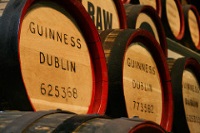
Although Guinness is now brewed all over the world, St James's Gate, in the heart of Dublin, was where Arthur Guinness set up the business in 1759. The Guinness Storehouse celebrates Ireland's favourite brew by taking visitors on a journey, floor by floor, through the past, present and future of the world-famous beer. The glass atrium is shaped like a pint glass and each floor explores a different aspect of 'everything anyone ever wanted to know about Guinness', from the brewing process to who drank the first pint.Visitors can't view the actual brewing process but will be introduced to the machinery used through the ages, and watch videos explaining how it all works. The tour finishes with a complementary pint of the famous stout in the top-floor Gravity Bar, which is also the ideal place to watch the sun set over Dublin and admire the 360° views.Visitors can enjoy tasting sessions during the July and August summer program, as well as exhibitions and delicious Irish meals from a table d'hôte menu in the Brewery Bar or Source Bar. The onsite shop sells some excellent merchandise for Guinness lovers. There is very good wheelchair access to the whole facility.
Address : St Jamess Gate
E-mail : [email protected]
Website : www.guinness-storehouse.com
Telephone : +353 1 408 4800
Transport : Bus 51B and 78A from Aston Quay, bus 123 from OConnell Street or Dame Street.
Opening times : September to June: 9.30am-7pm July and August: 9am-8pm
Admission : Adults €18.50 adults. Concessions and discounts for online bookings available.
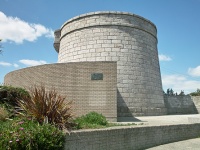
Located nine miles (14km) south of Dublin, the Martello Tower is one of 34 towers built in 1804 to protect Ireland against a possible Napoleonic naval invasion. The tower was demilitarised in the 1860s and is now home to the James Joyce Museum. Sylvia Beach, the Paris-based publisher of Ulysses, founded the museum in 1962. It was the place where Joyce stayed in 1904 and where he was inspired to set the opening chapter of his famous book.The exhibition hall contains first editions of most of Joyce's works as well as other interesting memorabilia, including one of the two official death masks made of Joyce, and reproductions of how the rooms would have looked when Joyce wrote the book. This is essentially a museum for Joyce fans, and it will delight lovers of Ulysses in particular. Those who are not in the know may not be overly captivated. Having said that, everybody who visits will be astounded by the lovely views and picturesque setting of the tower, and many find the historical structure interesting in its own right.The museum is now run by volunteers who are wonderfully friendly and enthusiastic. There is no charge for admission but donations are welcome.
Address : Sandycove Point, Dun Laoghaire, Dublin
Website : http://www.joycetower.ie/
Telephone : +353 85 1982218
Transport : DART to Sandycove, or bus 59 from Dun Laoghaire
Opening times : Summer: 10am-6pm Winter: 10am-4pm
Admission : Free
The highlight of this historic library is its great, domed reading room, which has been home to many Irish students, including James Joyce. This is a light-filled, peaceful and inspiring place to work, write or read, and should be on every scholar's bucket list. The reading room is open from 9.30am to 7.45pm between Monday and Wednesday, 9.30am to 4.45pm on Thursday and Friday, and 9.30am to 12.45pm on Saturday. Anybody is allowed to enter provided they respect the strict note about silence.The library also contains a heraldic museum, which exhibits coats of arms and banners. But, the genealogical office, where staff can help trace any Irish roots, may be of of most interest to tourists. Its consultation service on ancestry is available Monday to Wednesday 9.30am - 5pm, and Thursday to Friday 9.30am - 4.45pm. It's a free service and no appointment is required.One of the library's most famous and popular attractions is the award-winning Yeats exhibit: The Life and Works of William Butler Yeats. The exhibit is magical and compelling, taking visitors through Yeats' fascinating life. The collection includes rare material, which has been generously donated by Mrs George Yeats, the poet's wife, and Michael Yeats, his son, over several years. The library hosts other wonderful temporary exhibitions but the Yeats exhibit has been on show since 2006. It has become a permanent addition due to popular demand. There is also a cafe on the premises.
Address : 2 Kildare Street
Website : www.nli.ie
Telephone : +353 1 603 0200
Opening times : Monday to Wednesday 9.30am-7.45pm; Thursday and Friday 9.30am-4.45pm; Saturday 9.30am-12.45pm.
Admission : Free
The National Museum's permanent collection is broken up into four seperate museums, which have different locations in Dublin. The National Museum of Archaeology is on Kildare street, the National Museum of Decorative Arts and History is on Benburb street, the National Museum of Country Life is in Turlough Park, and the National Museum of Natural History is on Merrion street. All four establishments are great.The Natural History Museum is particularly good for kids, but the most popular and impressive is the Archaeology Museum, where many of the treasures of ancient Ireland can be found. Included in this museum is jewellery dating back to the 8th century BC and medieval antiquities such as the Tara Brooch and the Ardagh Chalice. Also housed here is the 12th-century Cross of Cong, an ornate reliquary of wood, bronze and silver, said to contain a fragment of the True Cross. The museum showcases important exhibitions on Irish history, including Prehistoric Ireland, Viking Ireland and The Road to Independence (1900-1921). There are also sections on Ancient Egypt and Life and Death in the Roman World. This is a truly world-class museum, which brings ancient Irish history to life.
Address : Varied locations. Check website for details.
Website : www.museum.ie
Telephone : +353 1 6777444
Opening times : Tuesday to Saturday 10am-5pm, and Sunday 1pm-5pm. Closed Mondays.
Admission : Free
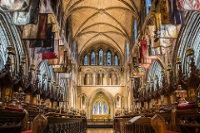
St Patrick's Cathedral is Ireland's largest church. It's erected on the site where St. Patrick is believed to have baptized his converts to the Christian faith when he visited Dublin. The current building dates back to the 12th century, although it has been restored and altered over the years.Jonathan Swift was dean of St. Patrick's from 1713 to 1745, during which time he penned Gulliver's Travels. Visitors can still see his tomb and pulpit. There are many tombs and memorials in the cathedral and it is interesting to get a guided tour to learn more about all the history on show. The cathedral has a nice little gift shop and really lovely grounds to enjoy. Marsh's Library is right next to the church. It is worth a visit for anybody interested in old, rare and unusual books. The cathedral still has daily services, which are open to the public.The church has a particularly impressive Boys Choir. Tourists have to pay a small fee for entry, with all proceeds going towards maintenance of the magnificent building. If, however, visitors want to attend a service to worship, there is no admission fee. The cathedral is sometimes closed for special services.
Address : St Patricks Close
Website : www.stpatrickscathedral.ie
Telephone : + 353 1 453 9472
Opening times : March to October: Monday to Friday 9am-5pm; Saturday 9am-6pm; Sunday 9am-10.30am, 12.30pm-2.30pm, 4.30pm-6pm. November to February: Monday to Saturday 9am-5pm; Sunday 9am-3pm
Admission : Adults €6.50. Concessions available.
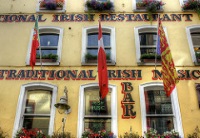
The Irish capital is known for its nightlife and many visitors come to Dublin primarily to enjoy the great beer, food, traditional music, and friendly locals that make the pub scene so famous.This quaint, cobbled district is the hub Dublin's toursit nightlight. There are shops, traditional pubs, theatres, cinemas and trendy clubs laid out on pedestrianised streets. Busking fiddlers, an overwhelming choice of restaurants, and beautifully restored buildings add to the feel of the place and make it worth a visit. The streets and drinking holes are always bustling in Temple Bar and the area has been immortalised by many photographers.The area is bordered by the Liffey River on one side and Dame Street on the other. The main street running through the area is also called Temple Bar. The weekly Temple Bar Food Market takes place between 10am and 4.30pm on Saturdays at Meeting House Square and this is a must for foodies. There are also several regular book markets in the area, and lots of little gems for clothes shoppers. The area has become rather expensive and some find it too touristy. That said, it's the place to be for the young and fashionable..
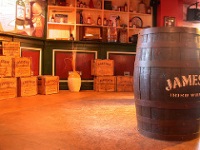
Jameson, who was actually a Scotsman, moved to Dublin to start a whiskey distillery in the 1770s and clearly made a lasting impression on the industry, despite the many distilleries making fine Irish whiskey in Dublin at the time.The Old Jameson Distillery is located in the heart of Dublin. Visiting is a treat for whiskey lovers, and there's a taste of Irish culture and history thrown into the bargain. This museum illustrates the history of Irish whiskey, known in Irish as uisce beatha(the water of life). The expert guides will answer any questions whiskey lovers might have. The tour takes visitors through the triple distillation process that sets Jameson apart. In the beginning there is a film explaining the 'Angel's Share', which is very interesting. A free glass of Jameson Whiskey is included in the tour and visitors can choose to partake in a whiskey tasting in the bar after their tour and sample different Irish, Scotch and American whiskeys.The tour lasts just over an hour, but guests can stay afterwards to enjoy the bars, restaurant and gift shop. A popular souvenir from the gift shop is a personalised bottle of whiskey, which will delight any whiskey drinkers back home.
Address : Bow St, Smithfield Village
Website : www.tours.jamesonwhiskey.com
Telephone : +353 1 807 2355
Transport : Both the Dublin Bus and the Sightseeing Hop On Hop Off bus stop at Smithfield (Stop 20). From there, its a short walk up Church Street and left on to May Lane/Bow Street.
Opening times : Open daily: Monday to Saturday 9am-7pm, Sunday 10am-6pm (last tour at 5:15pm). Closed Good Friday and Christmas holidays.
Admission : Adults €14, Children under 18 €7.70. Concessions available.
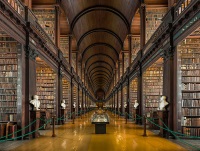
Trinity College is Ireland's oldest university and counts Jonathan Swift, Samuel Beckett and Oscar Wilde, along with many other great thinkers and writers, among its past students. It was founded in 1592 by Queen Elizabeth I. The complex is home to many glorious buildings, beautifully manicured lawns, cobbled squares and the campus of the University of Ireland.The main attraction for many is the Trinity Library. It houses the celebrated Book of Kells, which dates from the 8th century and is considered to be one of the oldest books in the world. Other manuscripts taken from ancient monasteries are also on display. Note that photography in this gallery is strictly forbidden.The library is also home to the remarkable Long Room, which will delight the scholarly. The chapel on the grounds is absolutely beautiful and a must-see for anybody interested in ecclesiastical architecture. There are lots of sculptures, statues and monuments dotted around the grounds to investigate. One of the best things to do at Trinity, however, is to simply make like a student and lounge on the lovely green lawns!
Address : College Green Dublin 2, Ireland
Website : www.tcd.ie
Telephone : +353 1 896 1000
Transport : The easiest way to access Trinity College is by bus. There are a number of stops around the campus.
Opening times : The Book of Kells is open Monday to Saturday 8.30am-5pm from May to September, and Sundays 9.30am-5pm. From October to April, it's open Monday to Saturday 9.30am-5p, and Sundays 12pm-4.30pm.
Admission : €11 Adults, concessions available.

Travel Guide powered by Word Travels, copyright © 2023 Globe Media Ltd. By its very nature information in this travel guide is subject to change at short notice and travellers are urged to verify information on which they're relying with the relevant authorities. Neither Globe Media Ltd nor Travel Vogue can accept any responsibility for any loss or inconvenience to any person as a result of information contained above.